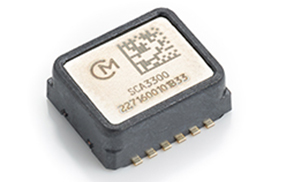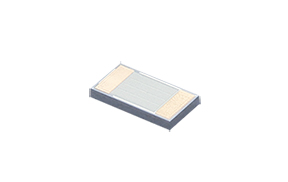SCC2000 Series Combined Gyro Sensor and Accelerometer

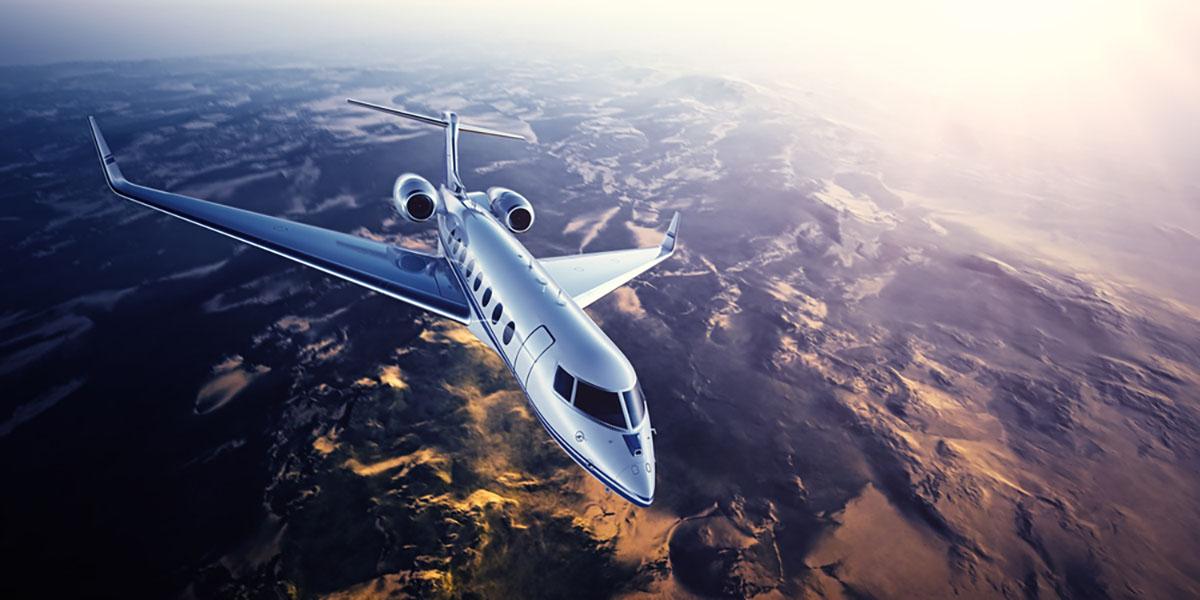
Power electrification and automated driving are being promoted at a remarkable speed for automobiles owing to advances in electronic technologies such as batteries, motors, and power electronics. On the other hand, strict safety requirements are imposed on aircraft engines. Therefore, electrifying them has been considered unfeasible on both a technical and commercial basis, which resulted in efforts in that area being shelved.
Nevertheless, the number of passengers in air passenger transport increased by about 2.7 times from 2001 to 2019*1. This has led to concerns about the negative impact on the environment from the exhaust gas accompanying the further increase in the number of flights in the future. Moreover, an increase in the number of accidents has also been predicted. Accordingly, there is a particular need for the development of autopilot systems that enhance safety during takeoff and landing when the accident rate is high.
We explain here the electrification of engines, which solves the problem of exhaust gas from aircraft, and the latest autopilot system technologies, which enhance the safety of aircraft operation.
*1: Source: Japan Aircraft Development Corporation (This linked page is in Japanese.)
Aircraft engines have been electrified up to now with a focus on auxiliary equipment such as hydraulic pumps and fuel supply devices. However, amid the international trend toward decarbonization, we have come to see that there is a limit to the extent to which we can curb the amount of exhaust gas with conventional efforts. Accordingly, attempts have begun in recent years to completely eliminate or greatly reduce exhaust gas by electrifying the engine itself (propulsion system). We explain here the limits of conventional efforts, the necessity of electrifying aircraft engines, the system of electric engines, and more.
Electrification has already been promoted in various devices installed on aircraft. This initiative is called More Electric Engine (MEE). It is a technology that electrically drives devices previously driven mechanically, hydraulically, or pneumatically. For example, the power required to drive fuel pumps and hydraulic pumps was obtained from jet engine power and bleed air*2. Replacing that with an electric motor reduces the load applied to the engine. Moreover, carbon dioxide emissions have been reduced by mixing bio-fuel called Sustainable Aviation Fuel (SAF) into aviation fuel, and fuel consumption has been improved by increasing the size of propulsion fans, among other measures.
Nevertheless, these measures are only improvements to the auxiliary equipment other than the jet engine and the fuel. There has been a limit to obtaining effects such as eliminating or greatly reducing exhaust gases.
*2: This is when some compressed air is extracted from a compressor in a gas turbine engine.
The International Civil Aviation Organization (ICAO), the International Air Transport Association (IATA), and other bodies have set a target to be achieved by 2050 of halving carbon dioxide emissions compared with the level in 2005. In the midst of such international trends, it has become clear that it would be difficult to achieve that target with the electrification of engine auxiliary equipment up to now and improvements in the fuel and the fuel consumption.
Accordingly, the electrification of aircraft engines is attracting attention as a technology to both handle the increase in aviation demand expected in the future and to reduce exhaust gases. If we replace jet engines with electric motors for aircraft engines, we will be able to eliminate or greatly reduce exhaust gases from engines. Therefore, the development of electric engines has become a pressing issue for many aviation-related research institutes and aircraft manufacturers.
There are two types of electric engine systems that replace jet engines: the pure electric system that obtains propulsion with just the electric motor and the hybrid system that employs both a jet engine and an electric motor.
This is also called the full electric system. The engine in this system consists of a secondary battery, an electric motor, and a propulsion fan (Fig. 1). The electric motor is driven by the power from the secondary battery. The propulsive power is obtained from the rotation of the propulsion fan. Absolutely no jet fuel is used in this system. As a result, there are zero carbon dioxide emissions. However, the propulsive power comes from the electric motor and only the secondary battery supplies power. Accordingly, it is difficult to fly a medium-sized or large aircraft with the energy density of current lithium-ion batteries. That means only small aircraft such as single-seater or two-seater can be flown with this system.

There are two types of hybrid system: the parallel hybrid system and the series hybrid system. These are systems that combine a jet engine or a gas turbine and an electric motor. It is possible to obtain large propulsion for a long period of time compared to the pure electric system. Therefore, these systems can also be used to fly medium-sized and large aircraft.
The engine in parallel hybrid systems consists of a jet engine, a secondary battery, and an electric motor driven by the secondary battery (Fig. 2). The propulsive power is obtained by rotating the propulsion fan using both the jet engine and the electric motor.
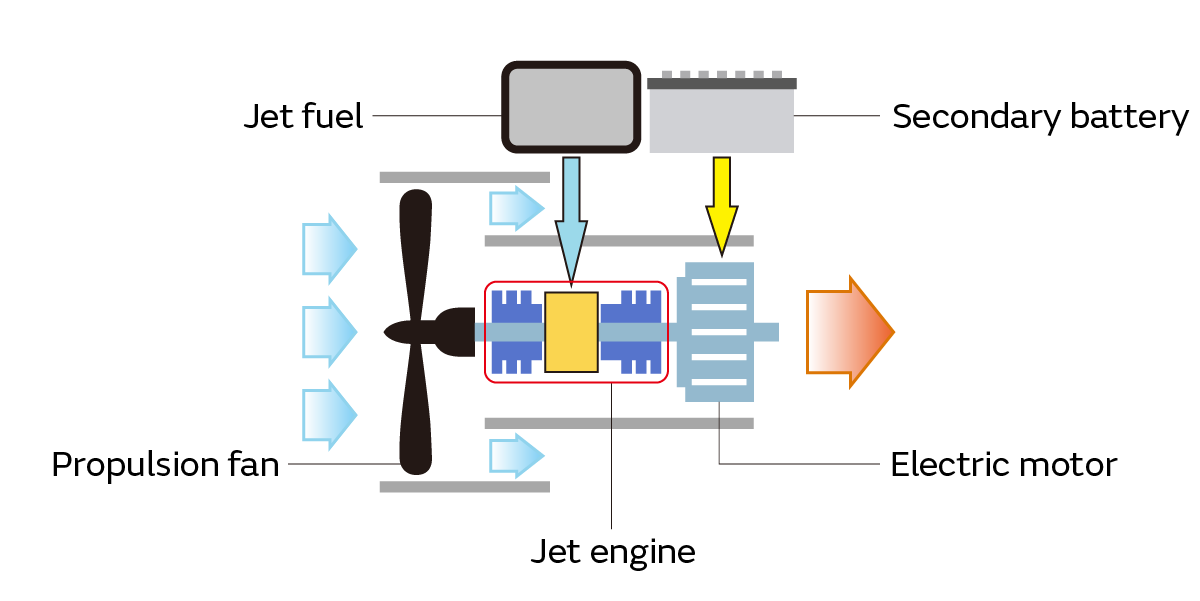
The engine in series hybrid systems consists of a generator, a jet engine for driving the generator, and a secondary battery in addition to the electric motor (Fig. 3). The rotation of the jet engine is transferred to the generator to generate power. The electric motor is then driven by that power to rotate the propulsion fan. The jet engine is used to drive the generator. This gives the system some advantages. There is a high degree of freedom in the location where the system is installed on the aircraft. There are also few restrictions on the placement position of the electric fans that generate propulsion and the number of those fans. Moreover, it is also possible to charge the secondary battery by regenerating the surplus power and the rotational energy of the jet engine when not using the electric motor.
The power generated by the jet engine drives the electric motor in this system. This means energy loss occurs during power generation. However, it is possible to improve the propulsion efficiency by optimizing the placement and number of propulsion fans utilizing the high degree of freedom in design.
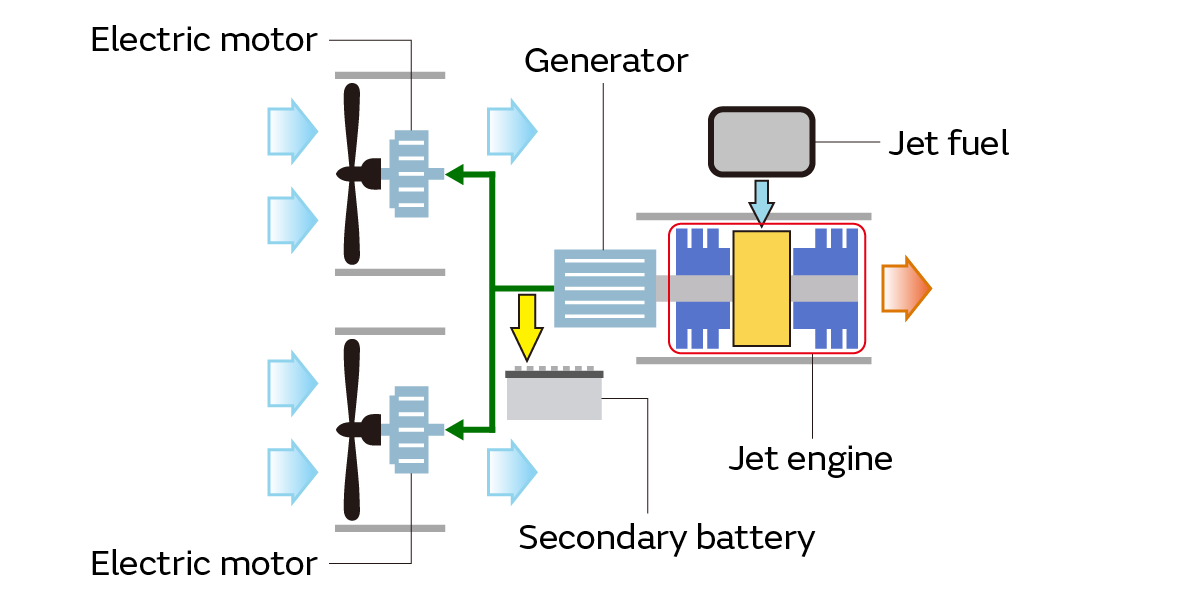
Aircraft autopilot systems have a long history. They are able to provide stable operation after takeoff. However, it has not been possible to use autopilot systems for taking off and landing in difficult conditions due to the accompanying danger. Nevertheless, it has started to become possible in recent years to operate aircraft with the autopilot system even under conditions that would once have been considered difficult. This has been achieved by improving the precision of radar, image recognition systems, and radio wave sensors, increasing the response speed of actuators such as motors and valves, and enhancing other areas. Against such a background, experiments have also begun recently to perform all operations, from takeoff to landing, with the autopilot system.
The autopilot system automates the operation of aircraft to reduce the operational burden on the pilot. When using the autopilot system, the pilot can operate the aircraft automatically by setting the altitude, bearing, speed, destination, and other conditions based on instructions from air traffic control, weather information, location information, information on aircraft in the surroundings, and other data.
In general, pilots leave operation to the autopilot system a few minutes after takeoff in the case of passenger planes. After that, it is possible to fly safely except in fog, strong winds, or other poor conditions. The pilot then manually operates the aircraft during landing when there is greater risk. Of course, pilots have the skills to perform all operations manually. However, there are many tasks performed by the pilot other than operating the aircraft such as flight management and drafting flight plans during the flight. Accordingly, it is possible to fly even more safely by entrusting operation to the autopilot system.
Autopilot systems have an aircraft attitude control function (pitch, roll, and yaw; Fig. 4), an altitude and speed control function, and a function to give guidance to the destination.

Of these functions, the aircraft attitude control and altitude and speed control are performed by the accelerometer, tilt sensor, and other sensors, and the FCC*3, ACC*4, and actuators*5. The sensors detect the attitude, direction, altitude, and speed of the aircraft. The detected signals are then sent to the FCC. The FCC sends the command to operate the actuators to the ACC. The ACC supplies the power required to drive the actuators. Through that, the actuators appropriately operate the ailerons, rudders, elevators, and other rotor blades. Safe flight by the autopilot system is achieved with that.
The actuator and rotor blade movements are also normally transmitted to and displayed on the monitors, meters, and other instruments in the cockpit. The pilot can see the operating status of each device and the attitude of the aircraft from the display on the monitors and meters. In addition, autopilot systems comprise multiple systems, as a failure could lead to a major accident. This ensures high reliability.

*3: Flight control computer (FCC): The FCC calculates the optimal steering angle according to the flight control law by taking into account the status of each device in the aircraft, the engine propulsion, the airflow, and other factors. It then outputs the signals that determine the degree of movement by the rotor blades (ailerons, rudders, elevators, etc.) to the ACC.
*4: Actuator control computer (ACC): The ACC supplies the power required to the actuators that drive the rotor blades according to commands from the FCC.
*5: Actuators: Actuators are devices that convert electricity, pressure (oil pressure, air pressure, etc.), heat, magnetism, and other forms of energy into mechanical motions such as rotation, expansion and contraction, and bending. Electric motors, hydraulic pistons, and electromagnetic solenoid devices are examples of actuators.
The issue that must be resolved as a top priority for the electrification of aircraft engines is the realization of a long cruising range. One way of extending the cruising range is to increase the amount of energy the aircraft is equipped with by loading more batteries onto it. However, unlike other transportation devices, it is not possible to tolerate an increase in the weight of aircraft by increasing the number of batteries. Therefore, it is necessary to improve the energy density of the batteries. Research and development are already underway in countries around the world to significantly improve the energy density of batteries. There have been reports such as those that say they have reached 450 Wh/kg at the cell level. If a level of about 500 Wh/kg is realized, it will be possible to expect that technology to be used as assist power during the takeoff and ascent of passenger planes with the hybridization of aircraft engines. Moreover, a water cooling system to cool the converters, inverters, and other devices is also a burden in terms of the weight. Accordingly, it is best to adopt an air-cooling system. This means it is necessary to use gallium nitride (GaN) or silicon carbide (SiC), which generate little heat, for semiconductors. Of course, there is also a need for a wide operating temperature range from high to low temperatures and vibration resistance for the electronic parts used in the peripheral circuits.
On the other hand, the autopilot system is a bundle of electronics technologies realized by many sensors, computers, and actuators. Therefore, improvements in electronics technologies lead directly to improvements in the functions and safety of the autopilot system. For instance, the FCC transmits electrical signals to the ACC in a fly-by-wire system in which the rotor blades are operated by those electrical signals. If electrical noise enters into these signals, it may cause the actuators to malfunction. For that reason, it is necessary to take measures against that using an optical fiber cable, which is not affected by electrical noise. Furthermore, it is essential to equip the system with a high-precision attitude indicator and an Attitude Heading Reference System (AHRS) to realize full autopilot system flight (autonomous flight), including takeoff and landing. These devices require MEMS sensors*6, which provide both high reliability and high performance.
In this way, electrical signals and electric power are responsible for many elements relating to flight in electric aircraft. Therefore, it is essential to improve electronics technologies to put electric engines into practical use regardless of their system.
*6: Basic knowledge of MEMS Technology
The advantage of electric aircraft is that they emit far less greenhouse gases than aircraft equipped with conventional jet engines. They are equipped with a flight system suitable for safe operation employing an excellent autopilot system.
In addition to improving the aerodynamic characteristics*7 of the aircraft and the efficiency of the power devices, it will also be necessary to do things such as acquiring technologies and knowledge through interaction with a wide range of fields such as aircraft materials and biotechnologies for the aviation industry in each country to advance globally in the field of electric aircraft in the future. The road ahead is by no means an easy one. There is a tendency to think that the realization of electric aircraft is still a long way in the future from the artist's impressions of such aircraft we can see today. Nevertheless, as we have stated, research and experiments toward the practical use of electric aircraft have already begun.
There are many technologies that have already been realized in other fields, including power electronics, high-power motors, and high-energy-density batteries in the field of electronics in particular. It will be possible to divert the use of those technologies to electric aircraft by further improving their performance. All this tells us that there is no doubt that the day is not so far off in the future when we will see environmentally friendly electric aircraft clear stringent safety requirements to be realized both technically and commercially.
*7: Aerodynamic characteristics: Examples of aerodynamic characteristics in the case of aircraft include air resistance, the force that pushes up the aircraft, and the air resistance ratio (lift-to-drag ratio). It is possible to lighten the load on the engine and to reduce the amount of fuel consumption by improving these characteristics.


